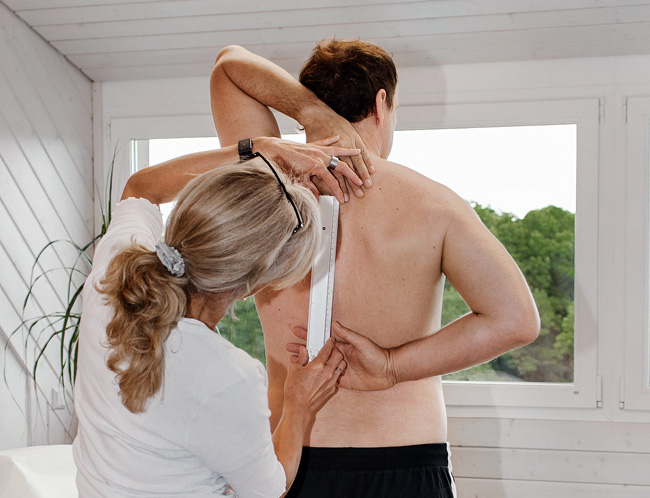The Back Scratch Test, or simply the Scratch Test, measures how close the hands can be brought together behind the back. This test is part of the Senior Fitness Test Protocol, and is designed to test the functional fitness of seniors. Another shoulder flexibility test designed for testing the elderly is the Shoulder Circumduction Test.
test purpose: This test measures general shoulder range of motion
equipment required: ruler or a yardstick
pre-test: Explain the test procedures to the subject. Perform screening of health risks and obtain informed consent. Prepare forms and record basic information such as age, height, body weight, gender, test conditions. Perform an appropriate warm-up. See more details of pre-test procedures.

procedure: This test is done in the standing position. Place one hand behind the head and back over the shoulder, and reach as far as possible down the middle of your back, your palm touching your body and the fingers directed downwards. Place the other arm behind your back, palm facing outward and fingers upward and reach up as far as possible attempting to touch or overlap the middle fingers of both hands. An assistant is required to direct the subject so that the fingers are aligned, and to measure the distance between the tips of the middle fingers. If the fingertips touch then the score is zero. If they do not touch, measure the distance between the finger tips (a negative score), if they overlap, measure by how much (a positive score). Practice two times, and then test two times. Stop the test if the subject experiences pain.
scoring: Record the best score to the nearest centimeter or 1/2 inch. The higher the score the better the result. Below is a table showing the recommended ranges (in inches) for this test based on age groups (from Jones & Rikli, 2002).
Men’s Results
| Age | below average | normal (inches) | above average |
|---|---|---|---|
| 60-64 | < -6.5 | -6.5 to 0 | > 0 |
| 65-69 | < -7.5 | -7.5 to -1.0 | > -1.0 |
| 70-74 | < -8.0 | -8.0 to -1.0 | > -1.0 |
| 75-79 | < -9.0 | -9.0 to -2.0 | > -2.0 |
| 80-84 | < -9.5 | -9.5 to -2.0 | > -2.0 |
| 85-89 | < -10.0 | -10.0 to -3.0 | > -3.0 |
| 90-94 | < -10.5 | -10.5 to -4.0 | > -4.0 |
Women’s Results
| Age | below average | normal (inches) | above average |
|---|---|---|---|
| 60-64 | < -3.0 | -3.0 to 1.5 | > 1.5 |
| 65-69 | < -3.5 | -3.5 to 1.5 | > 1.5 |
| 70-74 | < -4.0 | -4.0 to 1.0 | > 1.0 |
| 75-79 | < -5.0 | -5.0 to 0.5 | > 0.5 |
| 80-84 | < -5.5 | -5.5 to 0 | > 0 |
| 85-89 | < -7.0 | -7.0 to -1.0 | > -1.0 |
| 90-94 | < -8.0 | -8.0 to -1.0 | > -1.0 |
note: Normal range of scores is defined as the middle 50% of the population. Those scoring above this range would be considered above average for their age and those below the range as below average.
target population: the aged population which may not be able to do traditional fitness tests.
advantages: minimal equipment required.
other comments: The test is also sometimes called the Zipper Test, as the arm is placed down the back as if to pull up a zipper.
references:
- Anna Różańska-Kirschke, Piotr Kocur, Małgorzata Wilk, Piotr Dylewicz, The Fullerton Fitness Test as an index of fitness in the elderly, Medical Rehabilitation 2006; 10(2): 9-16.
- Jones C.J., Rikli R.E., Measuring functional fitness of older adults, The Journal on Active Aging, March April 2002, pp. 24–30.
The Test in Action
- This test is part of the Senior Fitness Test Protocol
Similar Tests
- Shoulder Stretch — can the hands can be brought together behind the back.
- Shoulder Reach Flexibility Test — can the hands can be brought within 5cm behind the back.
- Apley's Shoulder Scratch Test — shoulder movement measured by reaching behind to touch the opposite scapula.
- Shoulder Circumduction Test — another shoulder flexibility test designed for testing the elderly.
Related Pages
- Other flexibility tests.
- Flexibility Test Videos
- Read a discussion about testing the elderly.
- All about the Senior Fitness Test.
- Read about Fitness Testing for Specific Groups and Special Populations.
Related Products
- Buy the Senior Fitness Test Manual
- Flexibility Store — apparatus to measure flexibility.


 Current Events
Current Events